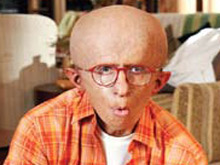Health Topics
-
Healthy Living
-
|
|
January 2010
|
| Progeria |
| Dr Chinmoy Kumar Maity |
| |
 |
Amitabh Bachchan, without his baritone or white goatee, is still stealing hearts around the country as Auro, in the Hindi film Paa. Here is looking at the condition called progeria which the movie brought into the limelight |
Progeria is an extremely rare genetic disorder affecting children and is characterised by premature rapid ageing. The word progeria comes from the Greek word progeros (pro meaning before, and geros, meaning old age) meaning prematurely old. Because progeria was medically observed first by Dr Jonathan Hutchinson (in 1886) and Dr Hastings Gilford (in 1897), this condition is also named after them, as Hutchinson-Gilford Progeria Syndrome (HGPS).
Only a bit more than 100 cases of progeria have been formally identified in medical history - and there are only about 45 known patients currently in the world. The approximate incidence is one in four to eight million births (!), and it can affect male and female equally.
Genetic Mutation
Progeria is caused by genetic mutation. It happens when a defective form of the protein Lamin A - normally necessary to make a protective envelope around the cell nucleus – is formed by a chance point mutation in chromosome 1. Progeria is usually not an inheritable disorder, but a uniquely inheritable form has been observed too, in two instances – one, a family from the Chhapra district of Bihar having five children with progeria, and the other, a family from Belgium having two children with this condition.
The Symptoms
The affected children are usually normal at birth, but start developing symptoms and signs of the disorder around the age of 10-24 months. Although their physical ageing is five to ten times faster than normal, their mental development remains unaffected – like that of the children that they are. Now you know why Amitabh was going to school and playing pranks like a child in that movie, right?
The earliest symptoms include growth failure, poor dentition, loss of hair and body fat, joint stiffness, dislocation of hip, dry scaly thin skin and a distinctive appearance - a narrow shrunken small face and jaw with pinched nose, and a relatively large head compared to the small fragile body. Later on, these children develop premature cardiovascular diseases (heart attack, heart failure, stroke etc), after having accelerated hardening and narrowing of their arteries (atherosclerosis). If there is something to be thankful about, certain age-related conditions like neurodegenerative conditions (e.g. dementia), increased predisposition to cancers, cataracts and osteoarthritis do not occur in cases of progeria.
Those affected by progeria have a very short life-expectancy - from eight to 23 years, with an average of 13 years. More than 90 percent of those affected die from complications of accelerated atherosclerosis, such as heart attacks and strokes.
Treatment
There are no known effective curative treatments or preventive measures for progeria. Available treatment is usually focussed on reducing complications, especially of cardiovascular diseases, with low-dose aspirin and coronary artery bypass surgery etc. Physiotherapy for arthritic and respiratory problems is also useful. High-calorie diet may be beneficial to prolong life.
Animal studies with a type of anticancer drug, the farnesyltransferase inhibitors (FTIs), have shown some positive results. A trial with growth hormone has also been attempted, but without much success.
Diagnosis of progeria is usually suspected from its typical signs and symptoms and is confirmed with a genetic test. Such rare cases are best managed by an expert multi-disciplinary team working under a dedicated Child Development Centre. Joint care by a developmental paediatrician and a geriatrician with a set of specially trained paediatric therapists, psychologists and special educators can optimise the care of such victims.
Fighting the Stigma
Grossly abnormal physical appearance and apparent imbalance of mind and body can be a source of social stigma and lead to embarrassment and social isolation. Quality of life of these unfortunate patients can only be improved by proper education, counselling, psychotherapy and rehabilitation in the community. The role of family and social support remain the cornerstones for successful rehabilitation of these children. An understanding, sympathetic and helpful attitude by the society towards such ostracised children and their family will play an indispensable role in our fight against this rare but lethal genetic disorder. Media can play a very important role to increase public awareness about this condition, like how the movie Paa has done. |
|
 |
Dr. Chinmoy Kumar Maity is Consultant Physician & Geriatrician at Apollo Gleneagles Hospitals, Kolkata |
|
|